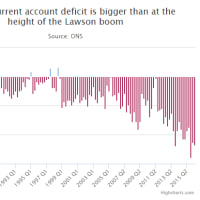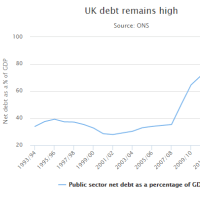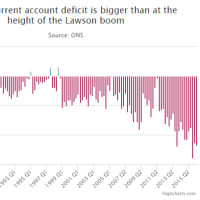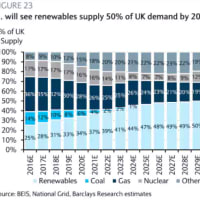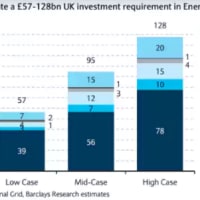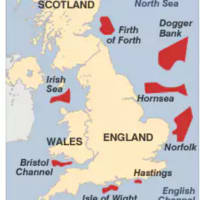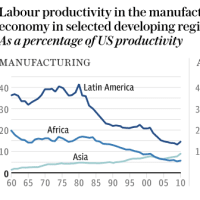Stagflation dragon stirs as factory prices soar
(工場価格急騰でスタグフレーションの化け物がゴソゴソ)
By Tom Stevenson
Telegraph:12/02/2008
(工場価格急騰でスタグフレーションの化け物がゴソゴソ)
By Tom Stevenson
Telegraph:12/02/2008
I invented a new index yesterday. From 2003 to 2007 it ran like this: 600, 1057, 1592, 1588, 1822. To be known as Stevenson's Stagflation index (SSI), it measures the number of articles in which my press cuttings database finds a mention of that unholy combination of sluggish growth and rising prices. As you can see, the SSI has been in a serious uptrend.
昨日、新しい指数を発明した。
2003-2007年はこんな感じだ:600、1057、1592、1588、1822。
SSI(スティーヴンソン・スタグフレーション・インデックス)として知られるこれは、ボクの切り抜きデータベースの中で、かの忌まわしい成長停滞と価格高騰のコンビへの言及がある記事の数なのだ。
おわかりだろうが、SSIは恐ろしく右肩上がりである。
Since the turn of the year, the index has gone exponential. The number of "stagflation" hits so far this year is 719. In the past six weeks the word has been used more than in all of 2003. At the current rate, my target for the year-end is about 6,000, a 200pc rise in a year. The dragon is stirring.
年が明けてからこっち、この指数は青天井だ。
今年これまでの「スタグフレーション」登場回数は719回。
この6週間と2003年一年間の登場回数は同じになってしまった。
今のペースなら、年末までに6,000回ぐらい?
年間成長率200%だ。
化け物が目を覚ましつつある。
If you're worried about inflation, then this is shaping up to be a scary week. Today's consumer price index (CPI) reading is expected to rise from December's 2.1pc to at least 2.4pc. Next up, expect tomorrow's Bank of England inflation report to warn that CPI will this year very likely reach the 3.1pc "letter-writing" level at which the Governor has to explain to the Chancellor what's gone wrong.
インフレが心配な人なら、今週は恐ろしい一週間になりつつある。
今日のCPIは12月の2.1%から少なくとも2.4%にはなると予想されている。
次はBoEのインフレ・レポートが、今年のCPIはどうも3.1%という、どこで何がどうおかしいのか財務相に説明しなければならないBoE総裁が「お手紙を準備する」レベルに達しそうだ、と警告する番だ。
Nothing in the rest of the week is likely to be as unsettling as yesterday's producer prices data, which showed a spectacular increase in manufacturing inflation.
今週中は、製造業インフレ率の物凄い上昇を見せ付けた、昨日の生産者価格データほど落ち着かないシロモノは飛び出さないだろう。
Input prices at Britain's factories rose 2.6pc month on month in January, taking the annual rate to 18.9pc. If you had to read that number twice, so did I. We haven't seen these kinds of inflation numbers since the dark days of lava lamps and bell-bottoms.
1月のイギリスの月次工場投入物価指数は2.6%上昇し、年率にして18.9%となった。
目をこすって数字を読み直したのは君だけじゃない。
ラーバ・ランプだのベル・ボトムだのが流行った暗黒時代からこっち、こんな数字見たことないし。
The obvious culprits - food and energy prices - played their part, but even stripping out these volatile elements, prices rose at their second fastest in 10 years. At the factory gate, even after manufacturers took a hit to their profit margin, the year-on-year rise in output prices was 5.7pc, way above consensus and the worst reading since 1991. A seasonally adjusted number is the worst since 1985.
明らかな犯人(食品価格とエネルギー価格)も一役買っているが、この変動要素を排除しても、価格上昇率は10年間で第2位だ。
メーカーが利益率を削った後ですら、工場出荷時の産出物価格の前年比対増加率は5.7%と、常識を超える1991年以来最悪の数値なのだ。
ちなみに季節調整後の数値は1985年以来最悪である。
Yesterday's report from the Office for National Statistics provided something else to worry about too. Import prices, which for more than a decade have disguised the soaring cost of home-grown services, are also on the move. For years the Bank of England winked at rising service sector prices because, with the cost of goods from China tumbling, domestic inflation was needed to prevent a slide into deflation. That fig leaf has now fallen.
昨日の国家統計局からのレポートも、心配の種を蒔いただけだった。
10年以上もの間、国内のサービス価格高騰を覆い隠してきた輸入価格も変わりつつある。
BoEは何年もサービス業の価格上昇に目をつぶってきた…中国から入ってくる商品価格が下がっていたので、デフレ回避のためには国内インフレが必要だったからだ。
今ではその隠れ箕も見事に消えてしまったわけだ。
This is why we've been unable to believe headline inflation figures. Things we buy infrequently like televisions may have got cheaper, but regular payments to hairdressers, schools and utilities have been rising for years.
これこそ我々がインフレ・データに関する新聞見出しを信じられなかった理由だ。
テレビのような頻繁に買い換えないようなシロモノは安くなったかもしれないが、美容院だの学校だの公共料金だの、定期的に金を払うものの価格は何年も上がり続けてきたのだ。
Globalisation, which initially pushed prices lower, has swung into reverse. Soaring demand in the emerging world fuels higher food and energy costs, which feed into higher wages in places such as China (inflation is at a 10-year high) and so into higher import prices here. Countries at the sharp end of the Asian boom, such as Australia, say prices are spinning out of control.
最初は価格を押し下げていたグローバライゼーションは、今では逆に作用している。
新興国の需要急増で食べ物やエネルギーの値段が吊り上がり、それは次に中国(10年ぶりの記録的インフレ率)などでの給与上昇を煽り、最終的に輸入品の値段を押し上げている。
オーストラリアのようなアジア・ブーム最前線にある国々は、価格が制御不能になっていると言っている。
A little bit of inflation is a good thing, because it acts as a tax on idle money. It persuades people not to leave their cash under the mattress or in low-interest accounts, but to put it to productive work.
タンス預金への課税みたいなものだから、ささやかなインフレは良いことなのだ。
金をタンスや低金利預金口座で眠らせないで、生産性の高いお仕事に費やすようにしてくれる。
Central banks like to maintain steady but low inflation because the alternatives are horrendous. In a deflationary environment, idle money is profitable, there's no reward for risk and you end up like Japan, in an endless lethargic slump. But high inflation is equally damaging because it diverts money out of economically "good" investments into inflation-proof safe havens such as gold, collectibles and (sometimes) property.
中央銀行は安定しているが低くインフレを保ちたがるものだが、これはその反対が無茶苦茶だからだ。
デフレ環境では、タンス預金がお得だし、リスクをとってもご褒美はないし、無限ループ不景気に陥って日本の二の舞だ。
が、高インフレも同じようにヤバイが、これは金を経済的に「良い」投資から、金だの収集品だの(時には)不動産だのといったインフレ抵抗力のある避難先に逃がしてしまうからだ。
The worst of all possible worlds is when inflation rears its ugly head even as growth slows. Stagflation holds a special place in the dark corners of economists' minds because it renders a central banker's monetary armoury powerless to fight a uniquely debilitating condition. He can't stimulate growth with lower interest rates because prices will take off and he can't bash inflation with higher rates because it will tip the economy into recession.
一番最悪なのは、成長が鈍化する時にインフレが鎌首を持ち上げることだ。
スタグフレーションはエコノミストの脳味噌の暗闇にある特等席でとぐろを巻いている…中央銀行家の金融の鎧を独特の衰弱性状態と闘うには無力にしてしまうからだ。
低金利では価格が暴走するから成長は刺激出来ないし、経済を不況の淵に蹴り落とすから高金利でインフレを退治することも出来ないのである。
In America, Ben Bernanke has thrown caution to the wind, slashing interest rates by 2.25 percentage points. He is gambling that he can avert recession this year and then turn his attention to rising prices. But history suggests that, as with toothpaste, it is easier to let inflation out of the tube than to squeeze it back in again.
アメリカではベン・バーナンキが思い切って2.25%も利下げを敢行した。
今年は不況回避、その後は価格上昇対応可能、という目に彼は賭けているのだ。
だが、インフレというのは歯磨き粉みたいなもんで、ひねり出すのは簡単だがチューブに戻そうと思うととんでもなく大変なのである、と歴史は語っている。
Inflation is fiendishly difficult to control and, like an oil tanker, slow to turn around. Yesterday's jump in producer prices followed a surge in the past year in a range of inflation expectation measures. There is a real danger these latest data are not just blips but a return to a lasting pick-up in price growth.
インフレは気が遠くなるほど制御困難だし、方向転換にかかる時間といったら石油タンカー並だ。
昨日の生産者価格急騰は、一年間の様々なインフレ予測指標の急上昇に続いて出現した。
これらの最新データは一時的なものではなく、長引く価格上昇への回帰である、という危険は本物だ。
Persistently rising prices matter to us all, but especially to investors, because inflation is the mortal enemy of financial assets. High inflation reduces the value of money received in the future, which is what investing is all about. The present-day value of future interest and principal repayments is reduced so bonds fall while investors in equities are less willing to pay high multiples of future earnings, the value of which is eroded by inflation. If profits are not even growing in nominal terms because the economy is slowing down, it all makes for a pretty vicious cocktail for investors.
価格が上昇し続けることは、我々全員にとって問題だが、金融資産にとってインフレは天敵である以上、投資家にとっては特に厄介だ。
インフレになれば、投資の本来の目的である、将来受け取る金の価値は下がってしまう。
インフレで価値が下がる予想収益に高い金を出す株式投資家の意欲が減退する間は、現在の将来の金利や元金返済の価値は減るから債券は下がる。
経済が景気後退中で名目上の利益すら増えないなどということになれば、投資家にとってはかなり致命的な状況だ。
We're not there yet, but Mervyn King should be applauded for taking the fight against inflation so seriously.
未だそこまで行っていないが、インフレとの闘いをこれほど真剣に捉えていることに対して、メルヴィン・キングは賞賛されねばならない。
 | KGBの世界都市ガイド晶文社このアイテムの詳細を見る |










